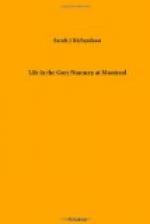“I found no instruments of torture, [Footnote: “The gag, the thumb-screw, and many other instruments of severe torture could be easily destroyed and others as easily procured. The non-appearance of instruments is not enough to sustain the current belief that the use of them is discontinued. So long as there is a secret prison, and while all the existing standards of inquisitorial practice make torture an ordinary expedient for extorting information, not even a bull, prohibiting torture, would be sufficient to convince the world that it has been discontinued. The practice of falsehood is enjoined on inquisitors. How, then, could we believe a bull, or decree, if it were put forth to-morrow, to release them from suspicion, or to screen them from obloquy? It would not be entitled to belief.”—Rev. Wm. H. Rule.] for they were destroyed at the time of the first French invasion, and because such instruments were not used afterwards by the modern Inquisition. I did, however, find, in one of the prisons of the second court, a furnace, and the remains of a woman’s dress. I shall never be able to believe that that furnace was placed there for the use of the living, it not being in such a place, or of such a kind, as to be of service to them. Everything, on the contrary, combines to persuade me that it was made use of for horrible deaths, and to consume the remains of the victims of inquisitorial executions. Another object of horror I found between the great hall of judgment and the luxurious apartment of the chief jailer (primo custode), the Dominican friar who presides over this diabolical establishment. This was a deep trap or shaft opening into the vaults under the Inquisition. As soon as the so-called criminal had confessed his offence; the second keeper, who is always a Dominican friar, sent him to the father commissary to receive a relaxation [Footnote: “In Spain, relaxation is delivery to death. In the established style of the Inquisition it has the same meaning. But in the common language of Rome it means release. In the lips of the inquisitor, therefore, if he used the word, it has one meaning, and another to the ear of the prisoner.”—Rev. Wm. H. Rule.] of his punishment. With the hope of pardon, the confessed culprit would go towards the apartment of the holy inquisitor; but in the act of setting foot at its entrance, the trap opened, and the world of the living heard no more of him. I examined some of the earth found in the pit below this trap; it was a compost of common earth, rottenness, ashes, and human hair, fetid to the smell, and horrible to the sight and to the thought of the beholder.




